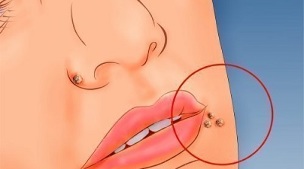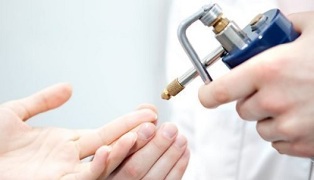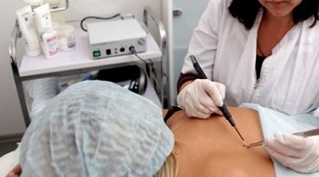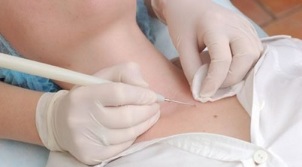The papillomavirus can easily be transmitted from person to person, an infection manifests itself in the form of warts. Treating warts is a complex process that should begin with diagnostic measures. A dermatologist can help you choose the right treatment.
Types of treatment for warts. The most effective methods of fighting

Warts or papillomas are harmless, benign growths that affect the appearance of the skin. Since this phenomenon does not look aesthetically pleasing, every person who has them tries to get rid of warts in all possible ways. But you also need to competently remove them, as papillomas can have a malignant connotation and instead of getting rid of a skin infection, you end up with a serious oncological condition.
Warts are dense, pea-sized skin bulbs with an uneven surface. The back of the hands, palms, and fingers are most commonly affected by warts. Some people have warts on their face, lips, armpits, and legs.
The warts that are on the sole of the foot are the most painful. They can reach large sizes and cause a lot of discomfort to their owners. Plantar warts are most commonly affected by people of retirement age.
Before starting treatment, a person must consult a specialist to confirm that this neoplasm is exactly a wart. There are several methods of removing them: from creams and gels to surgery to the use of traditional medicine. In any case, the doctor will prescribe treatment for warts and papillomas individually.
Cryodestruction
The most common method of removing papillomas and warts from the skin is to destroy them with liquid nitrogen. This process is known as cryodestruction. The impact on the affected skin occurs with liquid nitrogen, which reaches a temperature of minus 190 degrees. The wart freezes, the cells of the neoplasm are cooled, and the freezing of water in the tissues of the cells leads to their rupture, thereby destroying the papilloma. Under the influence of liquid nitrogen, the affected tissue dies and no scars remain on the site of the former neoplasm.
Sequence of the operation

Freezing is carried out with a cryoprobe or manually with cotton swabs. The manual method is the most popular because it does not require a large clinic expense.
A patient may need pain relief if:
- The neoplasm is great.
- Papilloma is located on a sensitive area of skin.
- The sites for removing neoplasms in children are subject to mandatory anesthesia.
The procedure itself boils down to simple mechanical movements: the doctor dips a cotton swab into a liquid nitrogen compound and touches the neoplasm with light pressure. The exposure time is limited only by the size of the neoplasm and its type. Sometimes it is necessary to treat the tissue of the neoplasm with nitrogen in order to completely destroy its structure. The repeated moxibustion procedure is necessary for plantar warts.
Signs of burns appear at the exposure site, similar to thermal injuries. A liquid bubble will appear on the skin. It is these states that show the process of complete destruction of the papilloma.
Electrocoagulation
Safe and effective way to get rid of various skin neoplasms also used to cure all types of warts. Electrocoagulation can only eliminate the growth of the upper skin, but it cannot remove the human papillomavirus itself. The likelihood of relapse is possible in more than half of the cases, so it is necessary to fully address the problem.
Functions of the procedure
The electrocoagulation method allows you to quickly get rid of such a cosmetic defect, but there is always a risk of scar tissue formation at the exposure site.

And no specialist can guarantee the complete disposal of such neoplasms.
Therefore, before using serious destructive methods of combat, it is necessary to try all the means of traditional medicine. Because folk recipes are safer and have less risk of scar tissue formation.Since the removal is done with an electronic loop at high temperature, the method is less safe than traditional topical preparations.
Contraindications
For the treatment of warts by electrocoagulation, it is necessary to consult a specialist and identify possible individual contraindications.
Frequent contraindications are:
- Availability of auxiliary devices for the cardiovascular system (heart monitor or pacemaker, pacemaker).
- Contraindications in connection with intolerance to high currents.
- Allergic reactions to anesthetics.
- Inflammatory processes in the body of an acute nature, which are due to infectious diseases.
- Haemophilia and vascular diseases at the capillary level.
The use of the electrocoagulation method is not recommended for plantar-type warts as there is a high risk of scarring with such exposure. Hard scar tissue interferes with proper walking.
recovery period
No additional medical treatment is required after destruction with an electrocoagulator. In rare cases, additional prevention of warts is carried out with the help of antiviral drugs.
Treating a wound with an antiseptic is all that is required to recover from surgery.
The only thing that needs to be done for several days is to treat the exposure site with a skin antiseptic.
Laser treatment
Anyone who has ever looked for methods to effectively treat warts knows that laser exposure is the safest. The use of a laser in aesthetic cosmetology will help get rid of various neoplasms and not leave scars. The advantage of this construction is the precision of the beams.
Before using this method to cure papillomas, you need to consult a specialist and undergo a certain examination.
Execution process and consequences
The operation is performed under local anesthesia, so the patient is asked to undergo an examination for blood diseases and tolerance to such effects. Those who are concerned about the possible complications from exposure to a laser should carefully consult with the choice of a specialist, since the safety of the procedure depends only on his qualifications. The doctor will select the required depth of the laser action and perform the moxibustion.
Exposure to high laser temperatures can completely destroy the harmful cells of the neoplasm without harming healthy ones. After such exposure, bleeding will not occur because the laser closes the blood vessels and the blood does not leak.
To avoid the appearance of scar tissue, traditional medicine - calendula tincture - must be used after the procedure. Do not apply alcohol lotions to the exposure site. This can cause irritation and make it difficult for the tissue to heal.
Contraindications

Despite the security in using this method, it is not recommended if:
- pregnancy. During the period of hormonal changes at the exposure site, a tumor-like neoplasm in the form of a scar can form, which is difficult to remove.
- The procedure is not possible for cancer patients.
- Hormonal changes in the body during puberty and menopause are the same contraindication as having surgery during pregnancy.
Medicines
Modern medicine has made great strides in the treatment of warts. Therefore, in any pharmacy you can find a huge number of means to get rid of the external signs of the human papillomavirus.
The use of these funds is possible without consulting a specialist, but such self-medication can provoke skin cancer. Therefore, not every wart can be treated on its own. It is best to seek advice from a specialist, and then use drugs for papillomas.
Preparations of the phenolic subgroup with antiviral effects
Each of the drugs in this group contains antibacterial and antiviral components that allow a superficial effect on the neoplasm.
The required drug is selected by a specialist, but the use of such funds shows a visible effect only after a month of use.
Traditional medicine
In order to get rid of the visible manifestations of the presence in the body of the human papillomavirus, it is necessary to use folk remedies. Since these are gentle exposure methods, they should be tried first.
Greater celandine
The scope of celandine is not limited to its effects on the skin. As a powerful and poisonous plant that contains a large amount of alkaloids, it has been used effectively to get rid of warts for many years. Treatment can last from several days to several months, depending on the severity of the neoplasm.
Celandine juice is smeared onto the wart several times a day. A visible effect with a slight manifestation of the virus is observed from the first days of application.

You can use celandine to make a healing ointment based on glycerine that can be stored in the refrigerator for a long time.
It cannot be used on more than five neoplasms at the same time, as celandine contains powerful components that can cause burns.
Some patients may experience allergic reactions to the use of celandine. Therefore, a skin reaction test should be performed on a small area.
acetic acid
A concentrated acetic acid solution can also be used to remove skin lesions. This method is both affordable and affordable. Daily treatment of the wart with acetic acid will help get rid of the neoplasm within a few days without harm and consequences.
ascorbic acid and salicylic acid
The daily intake of a few balls of ascorbic acid strengthens immunity and increases the body's own resistance to the human papillomavirus. Some time after taking the drug, a decrease in the number and size of neoplasms is noted. However, ascorbic acid can be used not only inside, but also to wipe the place where papillomas accumulate.
Salicylic acid, as well as other wart repellants, help stop its manifestations if used for more than two weeks. The remedy is applied to the wart with a cotton swab overnight and stuck with a plaster.













































































